
Aside from creating new, innovative, market-leading products, the other goal of any product development team is to consistently streamline and improve the way they work.
This usually ends up being an entire job unto itself — and that’s why “product operations” aka ProdOps was created. ProdOps is a role or team within a business that supports the product development team by finding new tools and methods while fostering collaboration. ProdOps can make a huge difference to product development teams, and it’s increasingly important.
Competition between companies is fierce, and customers have a massive range of products to choose from. So, teams need to deliver exceptional products as efficiently as possible, with streamlined processes and the tools to work at their best. ProdOps helps make that happen.
32% of organizations have a ProdOps team or individual (PLA).
In this post, we're going to take a look at some of the best product operations tools currently available so that you can quickly build up an effective product development stack.
Product operations tools: What do product operations teams need?
When looking at product operations software and tools, you'll come across options in the following categories:
Product portfolio management (PPM) and roadmapping
Agile development tools
Usage analytics
Product experience
Data analysis and visualization
Heat mapping
User testing
A/B testing
Collaboration
Knowledge management
Collecting feedback
Prototyping / wireframing
It should be noted that you don't necessarily need a tool from each of these categories. There are many tools that can fill a few of these roles, and having 12+ tools is likely to end up slowing your team down anyway.
Instead, opt for a handful of tools that are well-suited to your team's needs.
It can be easy to get lost with so many products, platforms, and tools at your disposal.
Many teams juggle multiple tools and platforms to complete their work as best they can, but that’s not sustainable. Communication becomes nearly impossible without access to a centralized platform as you juggle links, emails, different file types, spreadsheets — the list goes on.
Thankfully, most product management platforms are quickly becoming a one-size-fits-all solution by offering everything you need in one package. A centralized platform helps teams restore some order to their workflow by bringing everything together. It acts as a command center where you can seamlessly access and manage everything you need.
If you used all of the individual tools listed, it would be hard to create an easy workflow. A centralized platform eliminates the need for constant app switching. You can track progress, assign tasks, and communicate with team members. This streamlines workflows reduces inefficiencies and saves precious time.
Having a holistic view of the product development process is crucial for any high-functioning product team. It lets you see the big picture, understand dependencies, and make informed decisions. With a centralized platform, you can monitor the entire product lifecycle, from ideation to launch. You can gather insights from user feedback, track performance metrics, and iterate on your product strategy. This comprehensive understanding helps you identify bottlenecks, seize opportunities, and steer your product toward success.
Google, Uber, Lockheed Martin, Apple, and Tencent employ the highest numbers of ProdOps professionals (Pendo).
Product operations FAQs
1. What is a product operations job?
A product operations professional is responsible for tasks that support the product team and product manager, such as:
Facilitating collaboration
Conducting user tests to understand how people interact with a product
Working with product managers and stakeholders to maximize efficiency
Gathering customer feedback to help product managers make data-driven decisions
Experimenting with products to identify best practices
Managing the product team’s tech stack
Analyzing and tracking a product’s post-launch performance to determine its success
Product operations streamline the product team’s processes and empower them to deliver a product that satisfies users.
Analyzing data to make vital product decisions is considered the most important product ops role (Product-Led Alliance).
2. What’s the difference between product operations and product manager?
A product manager’s work revolves around solving customer issues. They need to understand all the problems their product should solve, the features that will benefit users, and how to exceed expectations.
ProdOps has an internal focus, providing product teams with what they need to finish the product and launch on time.
Plus, their overall goals are different. A product manager drives the company towards hitting their targets and growing their customer base with fantastic products. Product operations help PMs do their best by eliminating obstacles, supporting the product development team, and aligning the company from the inside.
ProdOps teams or professionals are most common in North America, accounting for 57.3%. Asia has 20.1%, Europe 15.5%, and the rest of the world has the remaining 7.1% (Pendo).
3. Who uses product operations tools?
Product operations teams use ProdOps tools to make the product management team’s jobs easier. Tools help simplify essential ProdOps tasks, including:
Supporting and managing agile-centric teams
Analyzing product usage to understand the user experience
Gathering and analyzing data about user behavior, features, etc.
User testing to gain valuable insights about a product
A/B testing to compare and contrast two versions of a product
Collecting feedback from users to inform future improvements
Creating prototypes/wireframes
In these industries, the following percentage of companies use ProdOps (Pendo):
Internet - 12.1%
IT & services - 11.4%
Computer software - 7.9%
Production operations tools for 2024 and beyond
With that, let's get into our recommendations for product operations software in 2024 and beyond. These are some of our favorite tools, so be sure to give each one a thorough look-through.
1. airfocus

The first tool on our list of ProdOps software is airfocus.
airfocus is a versatile, comprehensive solution for organizing, overseeing, and monitoring product development. airfocus covers roadmapping, customer feedback integration, and more.
Product Ops can use airfocus for product operations to strategize tasks, prioritize objectives, centralize feedback, create customizable workflows, and analyze feedback from multiple sources (including social media). Plus, it’s super flexible, so you can create the ultimate product ops tool for your needs.
airfocus has powerful roadmapping views and templates. In it, product teams and team managers can assign tasks or items, attach as much metadata to these tasks as they like, and structure how these items move through your development cycle.
It's a great way to organize and prioritize your product development, and it's packed with plenty of collaboration features to work well for remote, hybrid, or in-person teams.
Benefits
airfocus is super versatile. While it's great for product teams, it can be just as valuable for marketers, developers, and even HR.
airfocus can integrate with a number of popular tools, including some that are going to be mentioned in this very list.
You can automate various tasks in airfocus and send out notifications to collaborators, saving you time while keeping everyone in the loop.
Call it bias, but we think airfocus answers most product managers' problems. We put our all into creating the best modular, flexible product management platform, so all product managers can get all the tools they need while still using a single, centralized platform. We know every team is unique, and we were tired of saying product management platforms that tried to make teams work their way. We didn’t want teams to force themselves to change their workflow, so we built a modular platform allowing teams to choose what they need. They can now avoid unwanted feature bloat and use tools with actual value.
Our roadmapping tools offer multiple views and templates to help you and your team communicate effectively, even to those less than tech-savvy stakeholders! Product teams and team managers can assign tasks or items, attach as much metadata to these tasks as they like, and structure how these items move through your development cycle.
Our highly flexible platform can help you prioritize your roadmap with various objective scoring tools. Try our Priority Poker, OKRs, or any other framework you could ever need, all within one platform.
You can even use airfocus to centralize all your user feedback, which is crucial in this customer-centric age. airfocus Insights helps product teams cut through the noise and uncover valuable insights that can put your product on top.
With all the integrations and collaboration features you could ever need, airfocus is a great way to organize and prioritize your product development journey.
Ratings: G2 - 4.4 stars
Demos: Getting Started with airfocus
Pricing: Plans start at $69 per editor per month.
Free trial: Yes
Pros:
Comprehensive platform with lots of features
Integrated customer feedback for fast analysis
Highly customizable
Simple task prioritization
Cons:
None that we can see, but let us know what you think!
2. Pendo
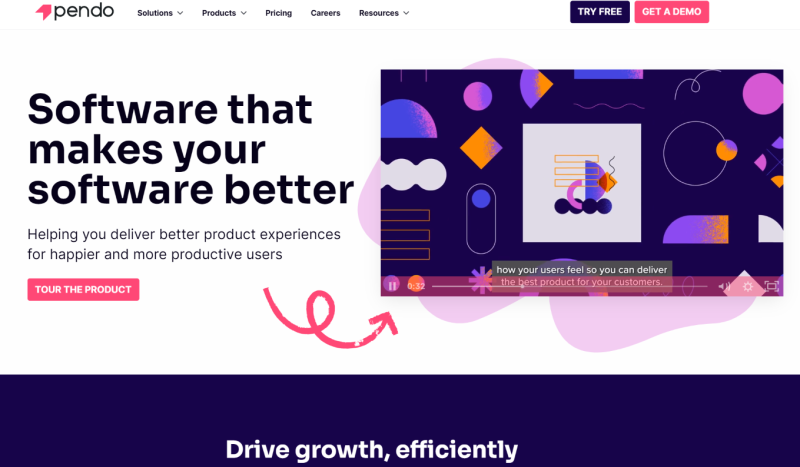
Pendo’s biggest strength is collecting and analyzing information on product usage. If product teams can identify how users interact with a product, product ops can help build processes to support these users.
Pendo also has good in-app communication, so teams can easily collaborate.
Rating: G2 - 4.4 stars
Demos: Pendo Onboarding Demo
Pricing: Available on request
Free trial: Yes
Pros:
User-friendly design
Enables ProdOps to monitor and analyze user behavior
ProdOps can assess a product’s performance at launch and beyond
Cons:
Initial configuration can be difficult
Pricing can be expensive
3. Hotjar
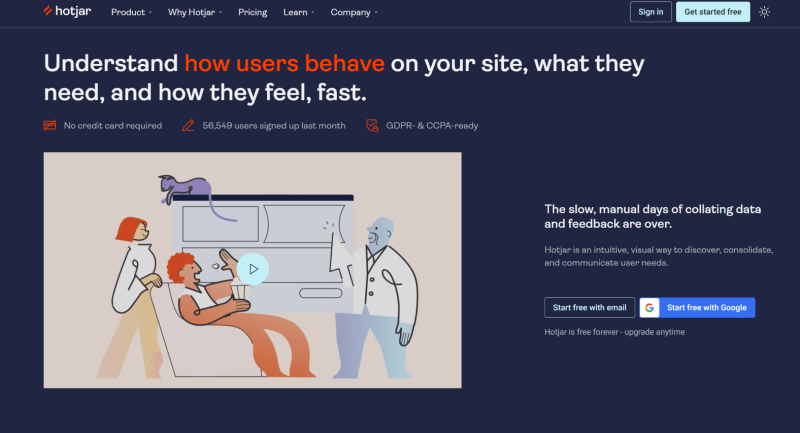
Product operations teams use Hotjar for instant feedback in a visual form with heat mapping. This is great for getting an insight into the user experience and testing a product.
Rating: G2 - 4.3 stars
Demos: Hotjar Demo
Pricing: Free for tracking up to 35 daily sessions, then $32 per month.
Free trial: Yes
Pros:
Get visual insight into user behavior
Real-time screen recording
Can be used for free on a small scale
Cons:
You may not need such intricate feedback
Lots of features can make getting started challenging
4. Jira
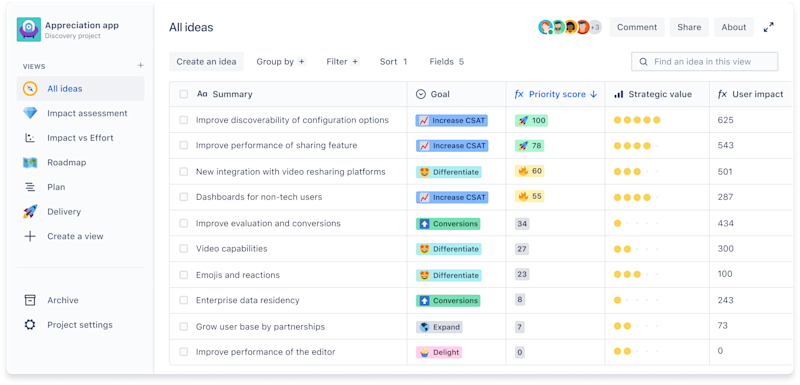
Initially created for bug tracking, Jira can help you manage many product tasks. Use it to track customer service requests, manage backlogs, and more. It can also be integrated with numerous tools, including DevOps solutions. Jira is one of the tools that integrates directly with airfocus, making the two a great pair. Jira is an agile development tool, meaning that it allows product development teams to use the agile method in a more organized way.
It includes features like a Kanban board, scrum, bug tracking, and automation. These features are things that you could do without Jira by using a whiteboard and notecards. However, Jira makes it easier to collaborate and keep your team in the loop.
Rating: G2 - 4.3 stars
Demos: Project Management with Jira
Pricing: Free version for 10 users. Paid plans start at $7.16 per user per month.
Free trial: Yes
Pros:
Easy task organization and prioritization
Extensive roadmapping and planning capabilities
Cons:
Integrating with other tools can be difficult
Negative reviews mention disruptive UI issues
5. Miro
Miro is an incredibly distinctive tool for product operations teams. Its visual sticky notes style makes collaboration easy, and it can be integrated with various other tools and ecosystems.
Rating: G2 - 4.8 stars
Demos: Miro for meetings and workshops
Pricing: Paid packages start at $10 per user per month.
Free trial: Yes
Pros:
User-friendly UI
Facilitates real-time collaboration
Visual approach makes brainstorming and sharing ideas easy
Cons:
Customization is limited
Lack of in-built prioritization features
6. Figma
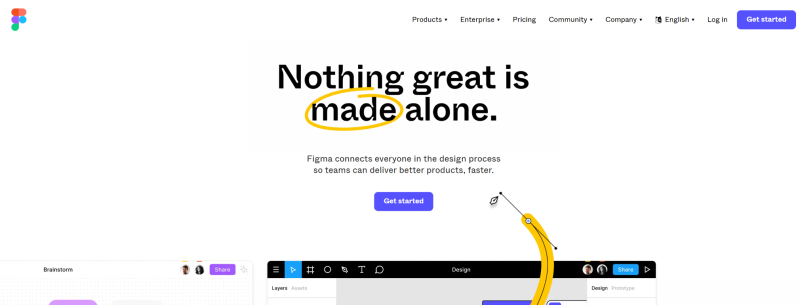
Figma is a cloud-based prototyping tool that provides ProdOps with the features to conduct user testing. It offers extensive collaboration between teams and stakeholders, allowing everyone to share their opinions on a prototype quickly and easily.
Rating: G2 - 4.7 stars
Demo: What’s Figma?
Pricing: Free basic plan available. Plans for professionals and companies from $15 per month.
Free trial: Yes
Pros:
Simplifies collaboration between developers and stakeholders
Creating and sharing prototypes is straightforward
Share opinions in real-time
Cons:
No offline mode
Tracking comments and changes is tricky with lots of users
7. Confluence
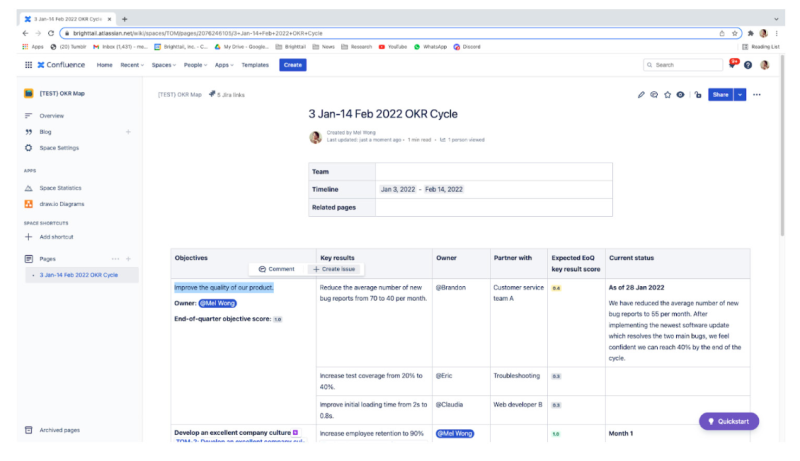
Confluence helps keep teams aligned in one workspace. Users can share an extensive range of materials in Confluence, from how-to guides to product updates. It also has real-time integration with other Atlassian tools.
Rating: G2 - 4.1 stars
Demo: Getting Started in Confluence
Pricing: Free forever for up to 10 users. Paid packages start at $4.89 per user per month.
Free trial: Yes
Pros:
Teams can collaborate on documents and stay aligned
Knowledge management module for accessing valuable content
Helpful for sharing product knowledge and updates
Cons:
May be difficult to use for newcomers to the Atlassian ecosystem
Setting up access permissions can be complicated
8. Typeform

Typeform gives ProdOps teams a simple way to gather user feedback through customizable quizzes, polls, and surveys. Choose from lots of templates and learn more about target users in a fun, convenient way.
Rating: G2 - 4.5 stars
Demos: Getting Started with Typeform
Pricing: Basic free plan available. Paid plans start at €25 per month.
Free trial: Yes
Pros:
Set up customizable and varied feedback materials
Manage feedback easily
Can be integrated with numerous tools, including MailChimp and Slack
Cons
Not ideal for deep data analysis
Other platforms offer more comprehensive data-gathering
9. Usersnap
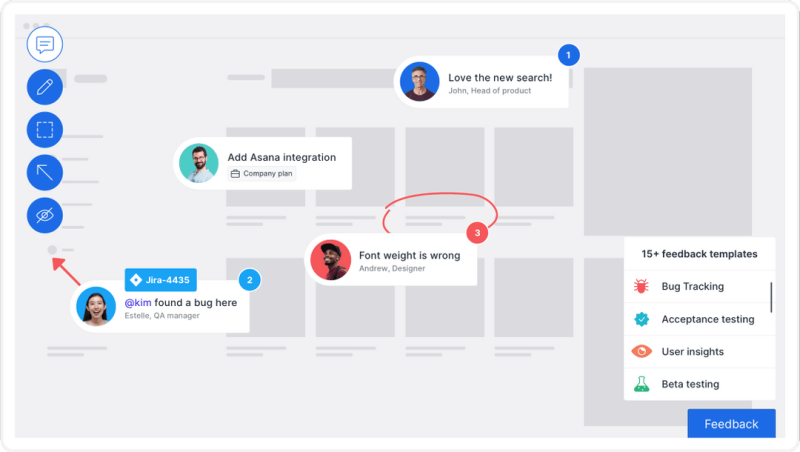
Usersnap is a customer feedback tool that integrates with websites directly and is useful for teams developing sites of all kinds. Users can use the widget to access a customer service menu and report issues directly, instead of looking up contact details.
Rating: G2 - 4.6 stars
Demos: Usersnap Demo
Pricing: Plans start at $49 per month for 5 users.
Free trial: Yes
Pros:
Lets you gather user feedback directly on a website
Comprehensive bug reporting tool that puts users in control when addressing issues
Gives a real-time insight into problems users encounter
Cons:
Integrating with a website and getting the most out of it can be complex
Not all users may be aware of the widget, understand it, or care to use it
10. Perdoo
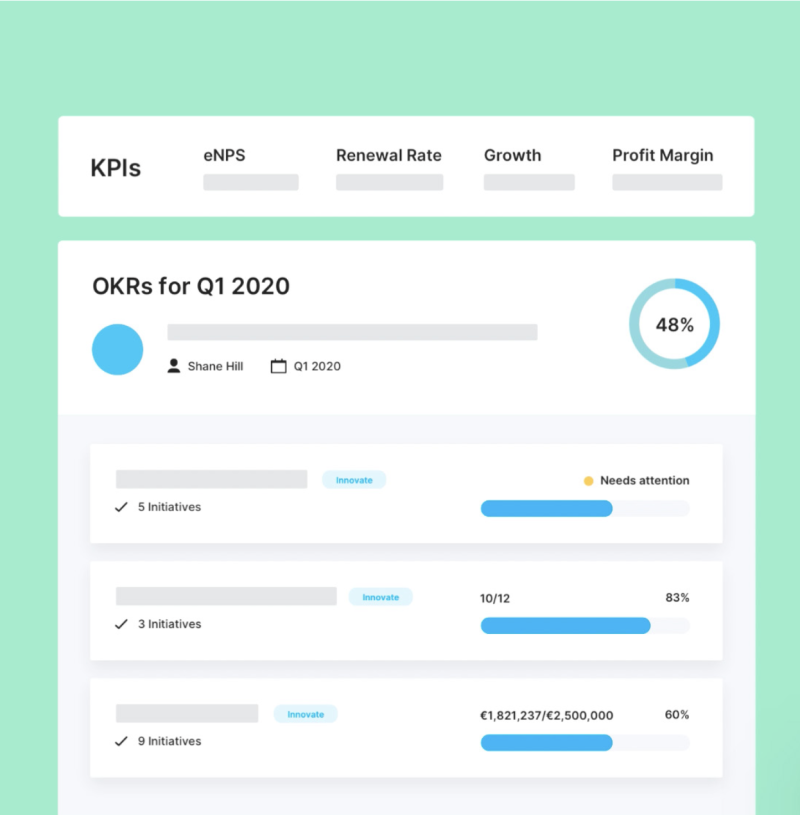
Using Perdoo, ProdOps can align everyone around shared goals. OKR and KPI tracking provide valuable insights into performance, which makes tracking progress simple. Employee engagement features also help teams stay motivated and on-target.
Rating: G2 - 4.4 stars
Demos: Perdoo Platform Overview
Pricing: Basic free plan for up to 5 users. Paid plans start at $9.90 per quarter for at least 10 users.
Free trial: Yes
Pros:
Real-time progress tracking to stay updated on achievements and issues
Automated reporting provides timely progress insights
Align teams and stakeholders easily
Cons:
Lots of features can make getting started difficult
Higher-priced plans may be too expensive for smaller businesses
Get everyone on the same page with the ultimate product operations tool
A single source of truth is essential in product management. Decision makers need fast access to real insights gathered from real users and real testing to understand how to solve problems and create stronger products. Product operations teams are vital for supporting, aligning, and empowering product teams to achieve their best. And the tools listed above will help them do that.
airfocus has all the features that product operations, managers, and developers need. Extensive roadmapping views, templates, feedback centralization, integrations, and collaboration features combine to make airfocus a powerful solution for creating products users will love.
Try it out for yourself today!
Learn more about product operations tools with airfocus' Product Ops ebook
You don't have to navigate the world of product operations alone. You can learn more about ProdOps efficiency right here.
The article was last updated in October 2024.

Tomas Prochazka

Read also



Experience the new way of doing product management

Experience the new way of doing product management



